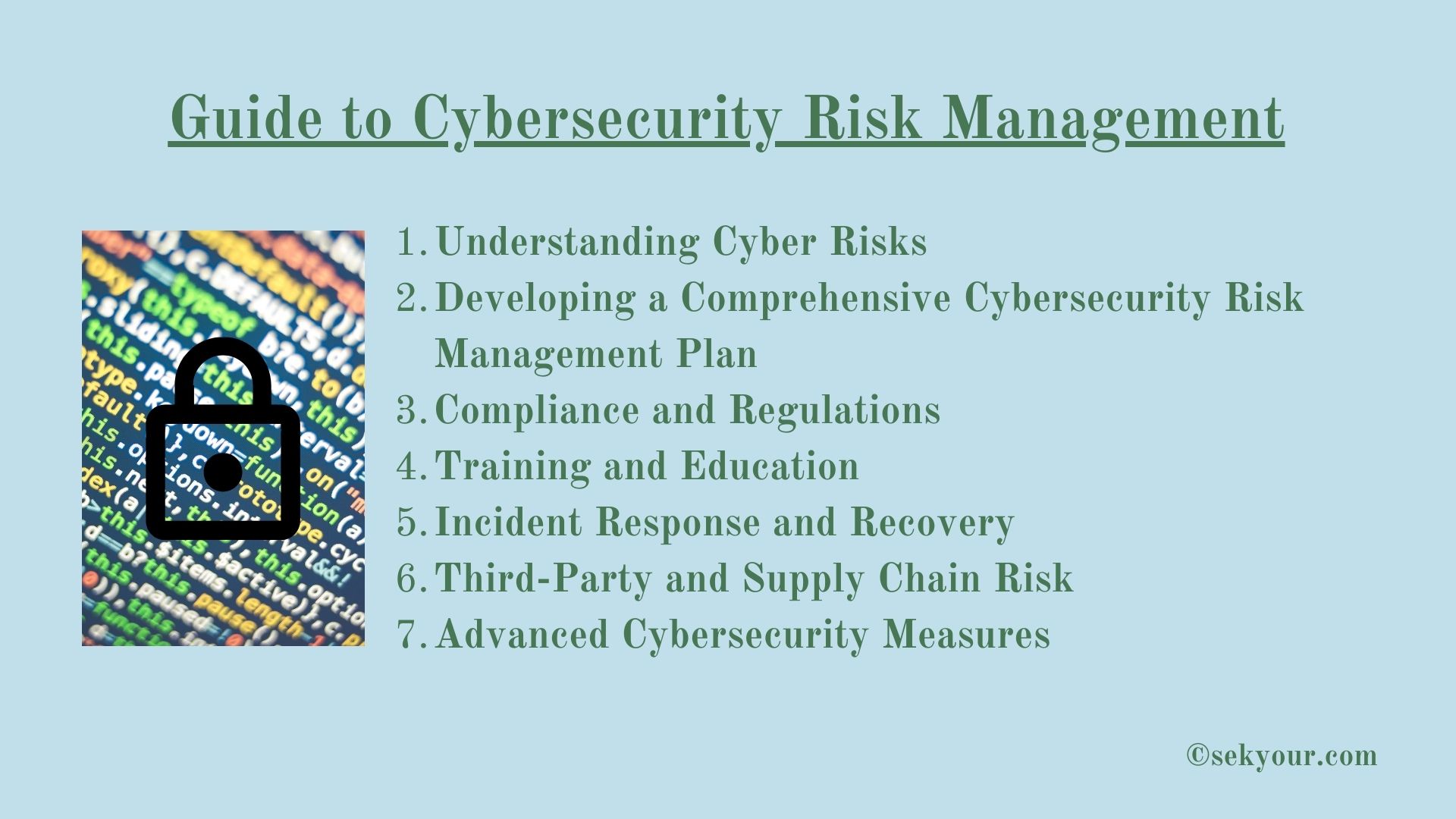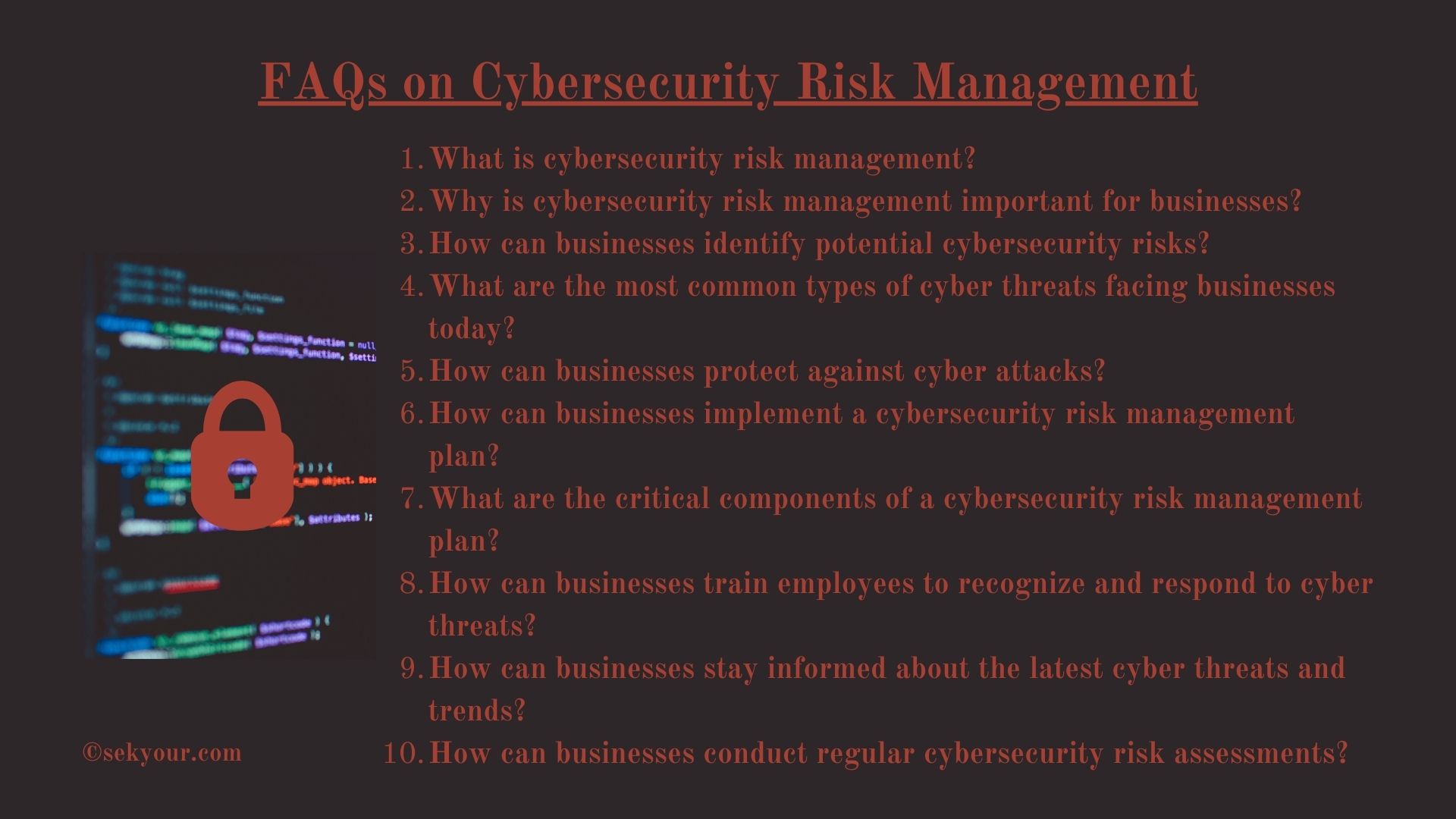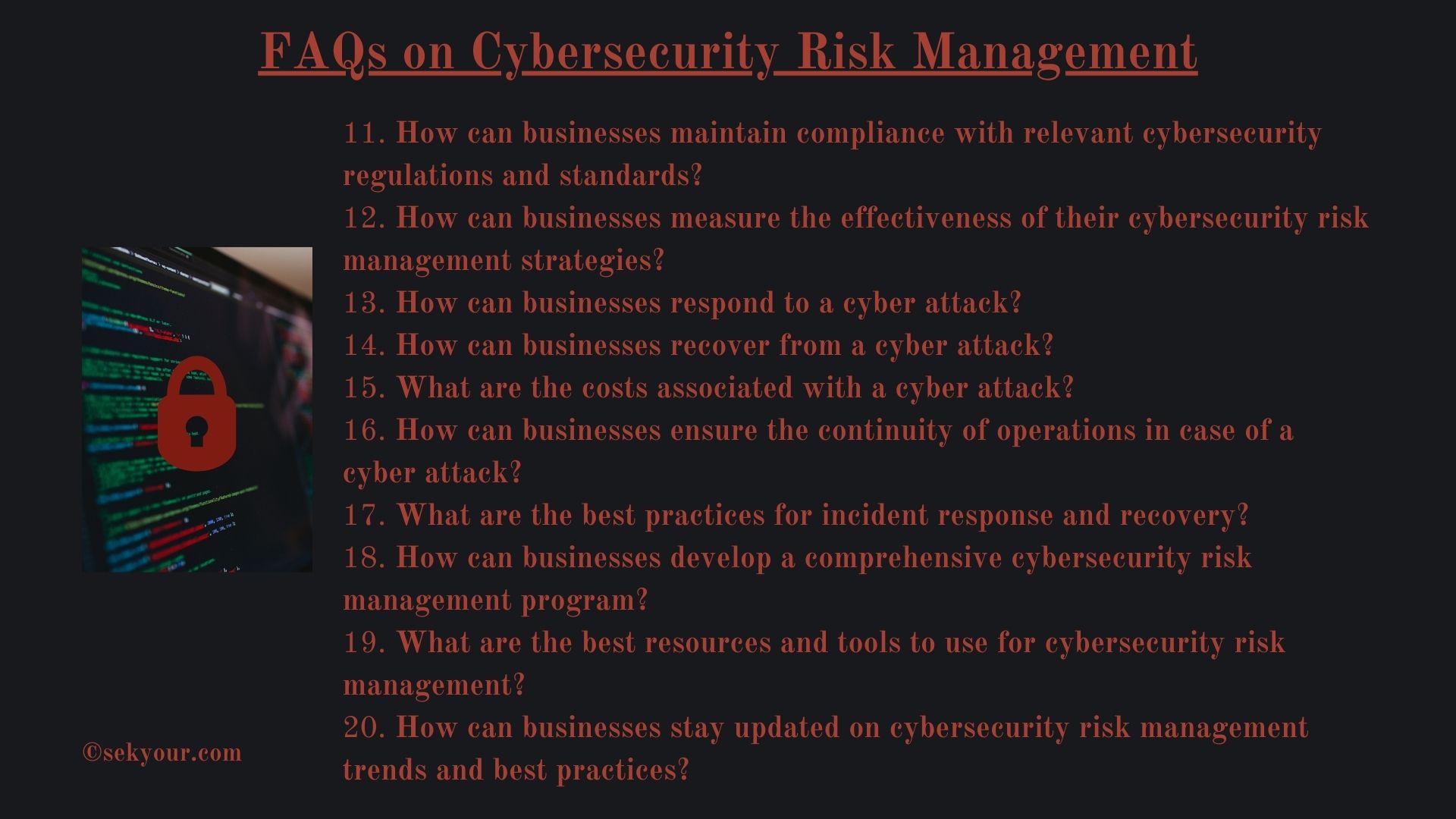1. Introduction
Cybersecurity risk management is crucial for businesses of all sizes as cyber-attacks are becoming more frequent and sophisticated. This article will provide a comprehensive overview of the current state of cyber threats, trends, and the potential impact of a cyber-attack on a business or organisation. Organizations need to implement robust cybersecurity measures to protect their assets and data.

2. Understanding Cyber Risks
Cyber threats come in many forms, including phishing, malware, and ransomware. Phishing is a tactic used by attackers to trick individuals into providing sensitive information, such as login credentials. Malware is malicious software that can be used to gain unauthorized access to a system. Ransomware is malware that encrypts a victim’s files and demands a ransom payment to restore access. According to the 2020 Verizon Data Breach Investigations Report, phishing accounted for 32% of data breaches and 58% of malware incidents were caused by Ransomware. Organizations need to understand the types of cyber threats they may face and identify potential vulnerabilities in their systems to protect themselves better. Understanding the attackers and their motivations can also aid prevention and mitigation efforts.
3. Developing a Comprehensive Cybersecurity Risk Management Plan
A comprehensive cybersecurity risk management plan includes identifying critical assets and data, developing a risk assessment process, implementing security controls and regularly monitoring and updating the plan. Identifying critical assets and data is essential to prioritize and protect them from potential threats. Developing a risk assessment process helps organizations understand and evaluate potential risks to their assets and data. Implementing security controls such as firewalls, antivirus software, and encryption can provide an additional layer of protection. It’s important to regularly monitor and update the plan to ensure that it remains effective in light of changing cyber threats and vulnerabilities. According to a study by PwC, only 38% of organizations regularly review and update their cybersecurity policies.
4. Compliance and Regulations
Compliance with relevant laws and regulations is crucial for organizations in terms of cybersecurity risk management. Laws such as HIPAA and PCI-DSS have specific requirements for protecting sensitive information. Understanding the role of compliance in cybersecurity risk management can help organizations understand the legal requirements and how to meet them. Navigating the compliance landscape and minimizing compliance risks requires ongoing monitoring and updating policies and procedures to ensure they remain compliant. According to a study by Deloitte, 64% of organizations need help to comply with regulations.
5. Training and Education
Employee education and awareness is crucial in preventing cyber threats and protecting sensitive information. According to a study by the SANS Institute, human error is responsible for 95% of cybersecurity incidents. Training employees on cybersecurity best practices and ongoing education can help reduce the risk of a data breach caused by human error.
Best practices for training employees on cybersecurity include providing clear guidelines for identifying and reporting suspicious activity, regular training on current threats, and simulations of phishing attacks.
Staying current on cybersecurity trends is also essential to keep up with evolving threats and adapt accordingly. For example, organizations should be aware of the latest tactics used in phishing attacks and the most recent ransomware variants.
A case-study example of employee education’s impact on cybersecurity is a financial services firm that implemented a comprehensive employee education and awareness program. As a result, the company saw a significant reduction in phishing-related incidents and an overall improved security posture.
6. Incident Response and Recovery
Incident response and recovery are critical components of a comprehensive cybersecurity risk management plan. Preparing for a cyber-attack includes developing an incident response plan, identifying potential threats, and identifying critical assets and data that need to be protected. The incident response plan should also include identifying the responsible parties, communication protocols, and procedures for restoring normal operations.
During a cyber-attack, it is crucial to take quick action to contain the damage and prevent further breaches. Steps to take during a cyber-attack include isolating affected systems, identifying the source of the attack, and implementing the incident response plan.
Recovering from a cyber-attack involves restoring normal operations, assessing the damage, and taking steps to prevent similar incidents from happening in the future. This may include implementing new security measures, revising incident response plans, and providing additional training to employees.
A case-study example of incident response and recovery is the example of a retail organization that fell victim to a cyber-attack. The company had a robust incident response plan, which allowed them to quickly contain the damage and minimize the impact on their operations. Through a combination of technical and procedural measures, the company could restore normal operations within a few days and continue strengthening their incident response capabilities.
7. Third-Party and Supply Chain Risk
Third-party vendors and supply chain partners can introduce significant risks to an organization’s cybersecurity. Understanding the role of third-party vendors in cybersecurity risk management is essential to identify and mitigate potential vulnerabilities. Assessing and managing risk in the supply chain can help organizations understand the potential risks associated with their partners and suppliers, and take steps to minimize those risks.
Best practices for securing third-party vendor relationships include implementing due diligence processes for new vendors, conducting regular risk assessments, and establishing precise security requirements for vendors. Organizations should also have incident response plans for vendor-related security incidents, and regular communication and collaboration with vendors to ensure that security measures are implemented and followed.
A case-study example of managing third-party vendor risks is a retail company, that recently suffered a data breach due to a vulnerability in a third-party vendor’s software. The company needed to assess the vendor’s security protocols adequately. As a result, they lost sensitive data and had to spend significant money to contain the damage. Following the incident, the company implemented new due diligence processes and regularly assessed the security protocols of their vendors to prevent a similar incident from happening in the future.
8. Advanced Cybersecurity Measures
As cyber threats become more sophisticated, organizations must implement advanced cybersecurity measures to protect their assets and data. Advanced threat detection and response techniques include tools such as intrusion detection systems (IDS) and intrusion prevention systems (IPS) to detect and respond to potential threats in real time. Artificial intelligence and machine learning can also identify and respond to threats and automate routine security tasks.
Cloud security is also an essential aspect of advanced cybersecurity measures, as more and more organizations are moving their data and applications to the cloud. Protecting data in the cloud involves implementing security controls such as encryption, and access controls and monitoring and assessing the cloud provider’s security.
9. Conclusion
In conclusion, cybersecurity risk management is essential for organizations of all sizes to protect their assets and data from cyber-attacks. This article has provided an overview of the current state of cyber threats, trends and the importance of understanding cyber risks, developing a comprehensive cybersecurity risk management plan, compliance and regulations, training and education, incident response and recovery, third-party and supply chain risk, and advanced cybersecurity measures.
Businesses must prioritize cybersecurity risk management and stay vigilant in the face of evolving threats. Organizations should regularly review and update their cybersecurity policies, train employees on best practices, and stay current on cybersecurity trends.
For further information and education, organizations can refer to various cybersecurity guidelines and best practices from government agencies such as the National Institute of Standards and Technology (NIST) and the Cybersecurity and Infrastructure Security Agency (CISA) and cybersecurity professional organizations such as ISACA, (ISC)² and SANS Institute. Organizations can also seek help and guidance from cybersecurity experts, consultants and service providers.
10. FAQs on Cybersecurity Risk Management

1. What is cybersecurity risk management?
Cybersecurity risk management is identifying, assessing, and prioritizing potential cybersecurity threats and vulnerabilities and then implementing appropriate controls to mitigate or prevent those risks. It involves a combination of technical, organisational, and management measures to protect sensitive information and systems from unauthorised access, use, disclosure, disruption, modification, or destruction.
2. Why is cybersecurity risk management important for businesses?
Cybersecurity risk management is essential for businesses because it helps protect against a cyber attack’s financial, legal, and reputational consequences. Cyber attacks can result in data breaches, loss of intellectual property, operational disruptions, and damage to a company’s reputation. By implementing appropriate cybersecurity controls, businesses can mitigate these risks and ensure their sensitive information and systems' confidentiality, integrity, and availability.
3. How can businesses identify potential cybersecurity risks?
Businesses can identify potential cybersecurity risks by conducting regular risk assessments, which involve identifying and assessing the potential threats, vulnerabilities, and impacts on the organization’s sensitive information and systems. Businesses can also use tools like vulnerability scans and penetration testing to identify vulnerabilities in their systems. Additionally, businesses can stay informed about the latest cyber threats and trends by subscribing to threat intelligence feeds, attending security conferences, and participating in information-sharing communities.
4. What are the most common types of cyber threats facing businesses today?
Today’s most common cyber threats facing businesses include phishing, ransomware, malware, and advanced persistent threats (APTs). Phishing attacks use social engineering tactics to trick users into providing sensitive information or clicking on malicious links. Ransomware is malware that encrypts a victim’s data and demands a ransom payment to decrypt it. Malware is a general term for malicious software, such as viruses and Trojan horses. APTs are long-term, targeted attacks often carried out by advanced threat actors.
5. How can businesses protect against cyber attacks?
Businesses can protect against cyber attacks by implementing a variety of technical, organisational, and management controls. Technical controls include firewalls, intrusion detection and prevention systems, and encryption. Organizational controls include security policies, procedures, and standards. Management controls include risk management, incident response, and disaster recovery planning. Additionally, businesses should regularly update software and systems and provide cybersecurity training to employees to protect against cyber attacks.
6. How can businesses implement a cybersecurity risk management plan?
Businesses can implement a cybersecurity risk management plan by following a risk management framework, such as the NIST Cybersecurity Framework. This framework provides a structured approach for identifying, assessing, and mitigating cybersecurity risks. The first step in implementing a cybersecurity risk management plan is to identify and prioritize the organisation’s assets and then set the potential threats and vulnerabilities to those assets. Next, businesses can implement controls to mitigate or prevent those risks and regularly monitor and assess the effectiveness of those controls.
7. What are the critical components of a cybersecurity risk management plan?
The critical components of a cybersecurity risk management plan include identifying assets, assessing threats and vulnerabilities, implementing controls, monitoring and assessing the effectiveness of those controls, and incident response and recovery. A cybersecurity risk management plan should include regular risk assessments, compliance with relevant regulations and standards, and employee training.
8. How can businesses train employees to recognize and respond to cyber threats?
Businesses can train employees to recognize and respond to cyber threats by providing regular cybersecurity awareness training. This training should cover topics such as identifying and avoiding phishing scams, best practices for password management, and how to report suspicious activity. Additionally, businesses can simulate phishing attacks and test their employees' responses, to help them identify and respond to real-world threats.
9. How can businesses stay informed about the latest cyber threats and trends?
Businesses can stay informed about the latest cyber threats and trends by subscribing to threat intelligence feeds, attending security conferences, and participating in information-sharing communities. Additionally, businesses can stay informed by regularly reviewing security reports and alerts from government organizations, such as the Department of Homeland Security and private sector security firms.
10. How can businesses conduct regular cybersecurity risk assessments?
Businesses can conduct regular cybersecurity risk assessments by following a structured methodology like the NIST Cybersecurity Framework. Risk assessments involve identifying and prioritising the organization’s assets and assessing the potential threats and vulnerabilities to those assets. Businesses can also use tools like vulnerability scans and penetration testing to identify vulnerabilities in their systems. Additionally, companies should regularly review and update their risk assessments to reflect changes in the threat landscape and the organization’s systems and assets.

11. How can businesses maintain compliance with relevant cybersecurity regulations and standards?
Businesses can maintain compliance with relevant cybersecurity regulations and standards by regularly reviewing and understanding the requirements of those regulations and standards, such as HIPAA, PCI DSS, and GDPR. Additionally, businesses can engage in regular self-assessments and third-party audits to ensure compliance. Businesses should also keep themselves updated on any changes in regulations and standards. They should also have policies and procedures to meet the regulatory requirements.
12. How can businesses measure the effectiveness of their cybersecurity risk management strategies?
Businesses can measure the effectiveness of their cybersecurity risk management strategies by regularly conducting risk assessments, penetration testing, and vulnerability scanning. Companies can also measure the effectiveness of their plans by monitoring the frequency and severity of security incidents and measuring the effectiveness of incident response and recovery efforts. Additionally, businesses can measure the effectiveness of their strategies by tracking key performance indicators, such as the number of successful phishing attempts and the number of vulnerabilities identified and remediated.
13. How can businesses respond to a cyber attack?
Businesses can respond to a cyber attack by activating their incident response plan. This plan should include clear roles and responsibilities for responding to an incident and procedures for containing and eliminating the attack, collecting evidence, and restoring normal operations. Businesses should also communicate with relevant stakeholders and authorities and take steps to prevent similar incidents from occurring in the future.
14. How can businesses recover from a cyber attack?
Businesses can recover from cyber attacks by implementing their incident response and disaster recovery plans. This should include steps for identifying and eliminating the attack, restoring normal operations, and communicating with relevant stakeholders and authorities. Businesses should also conduct a post-incident review to identify lessons learned and improve their incident response and disaster recovery plans.
15. What are the costs associated with a cyber attack?
The costs associated with a cyber attack include the cost of incident response and recovery, lost business and revenue, damage to a company’s reputation, and legal and regulatory fines. Businesses may also incur expenses related to the loss or theft of sensitive information, such as notifying affected customers, credit monitoring services, and legal fees.
16. How can businesses ensure the continuity of operations in case of a cyber attack?
Businesses can ensure the continuity of operations in case of a cyber attack by implementing a disaster recovery plan. This plan should include steps for identifying and eliminating the attack, restoring normal operations, and communicating with relevant stakeholders and authorities. Additionally, businesses should also conduct regular testing and updating of the disaster recovery plan, so that they can respond effectively in case of an attack.
17. What are the best practices for incident response and recovery?
The best practices for incident response and recovery include having an incident response plan in place, regularly testing and updating the incident response plan, clearly identifying roles and responsibilities, communicating with relevant stakeholders and authorities, and conducting a post-incident review to identify lessons learned. Additionally, having a disaster recovery plan and testing and updating it regularly is essential.
18. How can businesses develop a comprehensive cybersecurity risk management program?
Businesses can develop a comprehensive cybersecurity risk management program by following a risk management framework like the NIST Cybersecurity Framework. This framework provides a structured approach for identifying, assessing, and mitigating cybersecurity risks. The program should include regular risk assessments, compliance with relevant regulations and standards, employee training, incident response and recovery planning and testing, and regular reviewing and updating the program.
19. What are the best resources and tools to use for cybersecurity risk management?
The best resources and tools for cybersecurity risk management include risk management frameworks, such as the NIST Cybersecurity Framework, vulnerability scanning and penetration testing tools, incident response and disaster recovery planning templates, and security information and event management (SIEM) systems. Additionally, businesses can stay informed about the latest cyber threats and trends by subscribing to threat intelligence feeds and attending security conferences.
20. How can businesses stay updated on cybersecurity risk management trends and best practices?
Businesses can stay updated on the latest cybersecurity risk management trends and best practices by subscribing to industry publications and newsletters, attending security conferences, and participating in information-sharing communities. Additionally, businesses can stay informed by regularly reviewing security reports and alerts from government organizations and private-sector security firms. It is also advisable to have a dedicated team or person to keep updated and implement the changes as necessary.